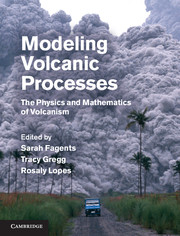Book contents
- Frontmatter
- Contents
- Contributors
- Chapter 1 Introduction
- Chapter 2 Magma chamber dynamics and thermodynamics
- Chapter 3 The dynamics of dike propagation
- Chapter 4 Dynamics of magma ascent in the volcanic conduit
- Chapter 5 Lava flows
- Chapter 6 Unsteady explosive activity
- Chapter 7 Unsteady explosive activity
- Chapter 8 Sustained explosive activity
- Chapter 9 Modeling tephra sedimentation from volcanic plumes
- Chapter 10 Pyroclastic density currents
- Chapter 11 Magma–water interactions
- Chapter 12 Deep-sea eruptions
- Chapter 13 Volcano–ice interactions
- Chapter 14 Modeling lahar behavior and hazards
- Chapter 15 Introduction to quantitative volcano seismology
- Chapter 16 Volcano acoustics
- Chapter 17 Planetary volcanism
- Index
- Plate section
- References
Chapter 5 - Lava flows
Published online by Cambridge University Press: 05 March 2013
- Frontmatter
- Contents
- Contributors
- Chapter 1 Introduction
- Chapter 2 Magma chamber dynamics and thermodynamics
- Chapter 3 The dynamics of dike propagation
- Chapter 4 Dynamics of magma ascent in the volcanic conduit
- Chapter 5 Lava flows
- Chapter 6 Unsteady explosive activity
- Chapter 7 Unsteady explosive activity
- Chapter 8 Sustained explosive activity
- Chapter 9 Modeling tephra sedimentation from volcanic plumes
- Chapter 10 Pyroclastic density currents
- Chapter 11 Magma–water interactions
- Chapter 12 Deep-sea eruptions
- Chapter 13 Volcano–ice interactions
- Chapter 14 Modeling lahar behavior and hazards
- Chapter 15 Introduction to quantitative volcano seismology
- Chapter 16 Volcano acoustics
- Chapter 17 Planetary volcanism
- Index
- Plate section
- References
Summary
Overview
There are many types of lava flow emplacement models. One type of numeric model aims to apply and link equations that describe lava flow cooling rates, rheology, and dynamics to simulate lava flow spreading. Generally applied to basaltic lava flow emplacement, it is this type of model that we consider here. Within this model type, we can define two simulation sub-types: volume- and cooling-limited. By applying and linking laws governing the ability of a Bingham fluid to spread under the influence of gravity, both volume- and cooling-limited simulations spread control volumes across a digital topography. Volume-limited approaches spread and thin a finite erupted volume until a sheet with a critical thickness defined by the lava yield strength is attained. For a cooling-limited model, heat losses due to radiation, convection, and conduction are estimated to calculate core cooling and crystallization rates. These can be used to estimate the rheological properties (viscosity, yield strength) of the lava. Rheological properties can be used to estimate flow thickness through a yield strength model, as well as velocity using the Jeffreys or Navier–Stokes equations. Such flow simulation models rely, in turn, on well-constrained models that define and link lava flow heat loss, cooling rates, crystallinity, rheology, velocity, and thickness.
Lava flows and lava flow models
Following the classic lava channel morphological model of Lipman and Banks (1987), an active lava flow system can be split into two principal components: a feeder system, which is either a channel or tube, and a zone of dispersed lava flow supplied by the feeder system. Within this system, a range of lava types, defined by their characteristic surface morphologies (including ˈaˈa, pahoehoe, transitional, blocky, and inflationary), can build a range of flow field architectures spanning simple, single-unit lava flows to compound lava flow fields comprising hundreds to hundreds of thousands of individual lava flow units (e.g., Walker, 1972; Kilburn and Lopes, 1988; Mattox et al., 1993).
- Type
- Chapter
- Information
- Modeling Volcanic ProcessesThe Physics and Mathematics of Volcanism, pp. 85 - 106Publisher: Cambridge University PressPrint publication year: 2013
References
- 11
- Cited by



